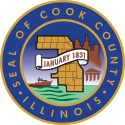Cook County Board President Toni Preckwinkle and Mayor Rahm Emanuel Applaud Congress For Passing The Workforce Innovation And Opportunity Act (WIOA)
The Chicago Cook Workforce Partnership and its 48 workforce agencies in Chicago and Cook County will benefit from new legislation
Today, President Obama signed the Workforce Innovation and Opportunity Act (WIOA) bill, authorizing $58 billion over six years for federal workforce development programs. This bill is the first reauthorization in 11 years to the previous Workforce Investment Act (WIA) of 1998. In general, the bill focuses on streamlining programs, reporting and administration.
Under the joint leadership of City of Chicago Mayor Rahm Emanuel and Cook County Board President Toni Preckwinkle, The Chicago Cook Workforce Partnership administers more than $50 million in federal, public, and private funds to provide comprehensive job training, career coaching and job placement services in the greater Chicagoland area.
While the previous legislation provided a framework for workforce programs the WIOA bill provides workforce agencies such as The Partnership with financial and policy supports to address future challenges. By 2022 the United States will fall short by 11 million the necessary number of workers with postsecondary education, including 6.8 million workers with bachelor's degrees, and 4.3 million workers with a postsecondary vocational certificate, some college credits or an associate's degree.
“This bipartisan and bicameral effort is a clear example of what government can accomplish when our elected leaders work together,” said Cook County Board President Toni Preckwinkle. “The Workforce Innovation and Opportunity Act will play a critical role in creating new jobs and boosting the local economy here in Cook County.”
The bill, which the House cleared for President Obama's signature on a 415-6 vote July 9th, modernizes and improves existing federal workforce development programs to be more responsive to the needs of employers, more efficient with taxpayer dollars, and more effective in connecting the unemployed with good-paying jobs.
“Chicago is the world class city we are today because we are known for the best trained, best educated workforce in the country,” said Mayor Rahm Emanuel. “This effort will further enhance that key economic edge, and making the City that Works work for all Chicagoans.”
In addition to winning strong bipartisan support in both chambers, the bill is supported by a broad array of labor, business, and workforce development leaders, as well as disability advocates, and legislators from around the country.
“Through modernizing and improving existing federal workforce development programs, agencies will help workers attain skills for 21st century jobs,” said Karin M. Norington-Reaves, CEO of the Partnership. “This legislation further strengthens our business engagement and enables us to deliver improved services.
There are key changes that will guide agencies to develop new practices. The Partnership is ahead of the curve in a number of areas from business engagement to data collection. The WIOA advocates the creation of smaller and more strategic state and local workforce development boards. Through The Partnership, Mayor Emanuel and Cook County Board President Preckwinkle reduced the region’s prior workforce boards from a total of 130 people to just 28.
Another change includes integrating intake, case management and reporting systems while strengthening evaluations. Through its creation of a data system known as the Integrated Workforce Information System (IWIS), The Partnership will significantly improve the collection and sharing of information among workforce agencies, due to launch in 2015.
Key changes include:
WIOA streamlines local workforce development systems by:
Eliminating 15 existing programs.
Applying a single set of outcome metrics to every federal workforce program under the Act.
Creating smaller and more strategic state and local workforce development boards.
Integrating intake, case management and reporting systems while strengthening evaluations.
Greater value by:
Maintaining the 15 percent funding reservation at the state level to allow states the flexibility to address specific needs.
Empowering local boards to tailor services to their region’s employment and workforce needs.
Supporting access to real-world education and workforce development opportunities.
Better coordination by:
Aligning workforce development programs with economic development and education initiatives.
Enabling businesses to identify in-demand skills and connect workers with the opportunities to build those skills.
Ensuring individuals with disabilities have the skills necessary to be successful in businesses that provide competitive, integrated employment
Improved outreach to disconnected youth and young adults 16-24 by:
Focusing youth program services on out-of-school youth, high school dropout recovery efforts, and attainment of recognized postsecondary credentials.
Providing youth with disabilities the services and support they need to be successful in competitive, integrated employment.
The Chicago Cook Workforce Partnership (The Partnership), oversees the second largest local workforce investment area in the U.S. and provides services to more than 140,000 job seekers and more than 200 businesses annually.
